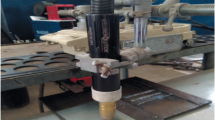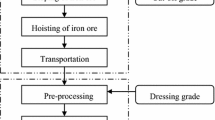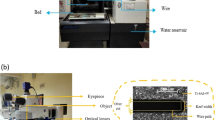Abstract
The inherent complexity in obtaining the desired microstructure in metals to achieve a specific set of mechanical properties makes the selection of an optimum level of alloy proportions and the heat treatment process parameters a challenging task. The differential evolution (DE) is a population-based evolutionary algorithm, which is capable of finding the optimal solution of non-differentiable, non-linear, and discontinuous functions. In this paper, a set of experimental data, obtained from literature, is used to train a multilayer perceptron (MLP) to predict the mechanical property (i.e., Vickers hardness number (VHN)) of austempered ductile iron (ADI), for a given set of input process parameters. A novel hybrid DE-MLP-based model is proposed to predict the input process parameters, i.e., the alloying element proportions and the heat treatment parameters, to produce ADI with a specific mechanical property. The performance of DE-MLP-based model in terms of accuracy, effect of population size, number of generations, and computational efficiency are discussed. With extensive simulation results, it is shown that the MLP model can predict VHN with a low mean absolute percent error (MAPE) of 0.21. With only 10 individuals, the DE algorithm is able to generate a feasible solution containing the input process parameters in less than 10 generations. ADI with a desired value of VHN can be produced using the alloying element proportions and heat treatment process parameters predicted by the proposed model.
Access this chapter
Tax calculation will be finalised at checkout
Purchases are for personal use only
Similar content being viewed by others
References
Arafeh, L., Singh, H., Putatunda, S.K.: A neuro fuzzy logic approach to material processing. IEEE Trans. Syst., Man Cybern. Syst Part C 29(3), 362–370 (1999)
Das, S., Suganthan, P.N.: Differential evolution: a survey of the state-of-the-art. IEEE Trans. Evol. Comput. 15(1), 4–31 (2011)
Haykin, S.: Neural Networks, 2nd edn. Prentice Hall, Upper Saddle River (1999)
Jiang, L.L., Maskell, D.L., Patra, J.C.: Parameter estimation of solar cells and modules using an improved adaptive differential evolution algorithm. Appl. Energ. 112, 185–193 (2013)
Keough, J.: Austempered Ductile Iron (ADI) - a green alternative. American Foundry Society, Schaumburg (2011). www.afsinc.org
Patra, J.C.: Neural network-based model for dual-junction solar cells. Prog. Photovoltaics Res. Appl. 19(1), 33–44 (2011)
Patra, J.C., Kot, A.C.: Nonlinear dynamic system identification using Chebyshev functional link artificial neural networks. IEEE Trans. Syst. Man Cybern. Part B 32(4), 505–511 (2002)
PourAsiabi, H., PourAsiabi, H., AmirZadeh, Z., BabaZadeh, M.: Development a multi-layer perceptron artificial neural network model to estimate the Vickers hardness of Mn-Ni-Cu-Mo austempered ductile iron. Mater. Des. 35, 782–789 (2012)
Savangouder, R.V., Patra, J.C., Bornand, C.: Artificial neural network-based modeling for prediction of hardness of austempered ductile iron. In: Gedeon, T., Wong, K.W., Lee, M. (eds.) Neural Information Processing, pp. 405–413. Springer International Publishing, Cham (2019)
Storn, R., Price, K.: Differential evolution - simple and efficient heuristic for global optimization over continuous spaces. J. Glob. Optim. 11(4), 341–359 (1997)
Varela, D., Santos, J.: A hybrid evolutionary algorithm for protein structure prediction using the face-centered cubic lattice model. In: Liu, D., Xie, S., Li, Y., Zhao, D., El-Alfy, E.S.M. (eds.) Neural Information Processing, pp. 628–638. Springer International Publishing, Cham (2017)
Yescas, M.A.: Prediction of the Vickers hardness in austempered ductile irons using neural networks. Int. J. Cast Met. Res. 15(5), 513–521 (2003)
Author information
Authors and Affiliations
Corresponding author
Editor information
Editors and Affiliations
Rights and permissions
Copyright information
© 2021 Springer Nature Switzerland AG
About this paper
Cite this paper
Savangouder, R.V., Patra, J.C., Palanisamy, S. (2021). Hybrid DE-MLP-Based Modeling Technique for Prediction of Alloying Element Proportions and Process Parameters. In: Mantoro, T., Lee, M., Ayu, M.A., Wong, K.W., Hidayanto, A.N. (eds) Neural Information Processing. ICONIP 2021. Lecture Notes in Computer Science(), vol 13111. Springer, Cham. https://doi.org/10.1007/978-3-030-92273-3_47
Download citation
DOI: https://doi.org/10.1007/978-3-030-92273-3_47
Published:
Publisher Name: Springer, Cham
Print ISBN: 978-3-030-92272-6
Online ISBN: 978-3-030-92273-3
eBook Packages: Computer ScienceComputer Science (R0)




